Ben buys groceries for $\$$155.50. He hands the store clerk $\$$500 and, in turn, gets $\$$344.50 back.
Without the knowledge of decimals, knowing the exact amount he needed to pay for the groceries wouldn’t have been possible.
Decimal numbers are numbers that have a decimal point in them. They have two parts: the first is the whole number (to the left of the decimal point), and the second is the fractional part (to the right of the decimal point).
For example, Sam buys oranges for $\$$3.50. Here,
- $\$$3.50 is the decimal number (the price of oranges)
- 3 is the whole number (to the left of the decimal point)
- 50 is the fractional part (to the right of the decimal point)
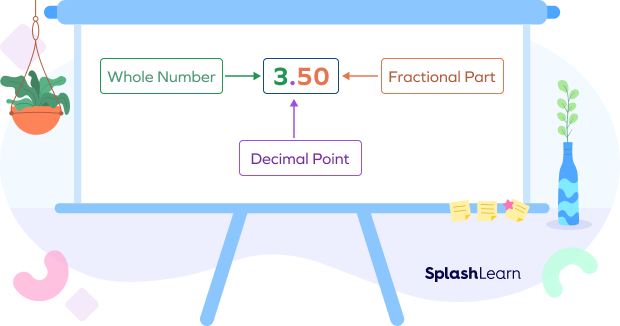
Decimals add more accuracy to your counting and are often used in day-to-day activities.
Decimals can be added, subtracted, multiplied, or divided depending on the particular scenario. Today, we will discuss subtracting decimals, their rules, and a few examples.
How to Subtract Decimals
Subtracting decimals is as simple as finding the difference between a greater whole number and a smaller whole number. Take the first example where the price of groceries was $\$$155.50. In this scenario, 155 is the whole number, and .50 is the fractional part.
Based on the place values, the decimal numbers must be arranged one below the other, not forgetting the decimal point during subtraction. However, if two decimal numbers are different, the subtraction can be a bit tricky.
Hence, to avoid such confusion, the decimal numbers can be changed to like decimal numbers by adding the required number of zeros.
The number of decimal places will be equal in like decimals. For example, 5.23 and 7.89 are like decimals, whereas 4.53 and 2.753 are unlike decimals.
Recommended Games
Subtracting Decimals without Regrouping
Let’s say we need to subtract 14.2 from 25.83. Here’s how to do it.
Step 1: 25.83 and 14.2 are unlike decimals. So first, we need to convert them into like decimals by adding a zero to the extreme right of 14.2 to make it 14.20.
Step 2: Position the smaller number below the greater number in such a way that the decimal points are lined up.
Step 3: Subtract each column from right to left as you would subtract a whole number.

Step 4: Place the decimal point in line with other decimal points.
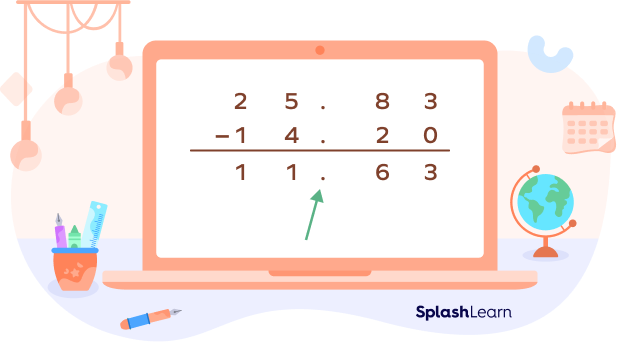
Recommended Worksheets
Subtracting Decimals with Regrouping
Regrouping in decimal subtraction is very similar to regrouping done in whole number subtraction. Let’s understand with the help of an example.
Let’s take an example of subtracting decimal 2.37 from 5.10. Here’s how to do it.
Step 1: The decimals are like decimals. So, let’s move to step 2.
Step 2: Position the smaller number below the greater number. Ensure that the digits are placed based on their place values, and the decimal points are accurately aligned.
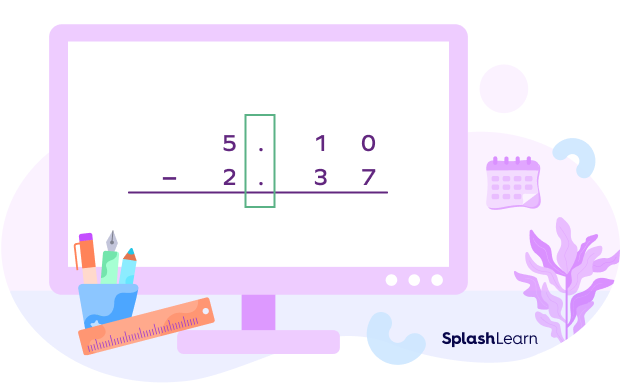
Step 3: Subtract each column individually, starting from the right and gradually shifting to the left.
- In case a number in the upper line is smaller than the one in the lower line, 1 should be borrowed from the left digit, adding 10 to the concerned digit. This is called regrouping.
- Once 1 is borrowed from the left digit, it gets reduced by 1. Hence, the subtraction can be continued with the reduced number.
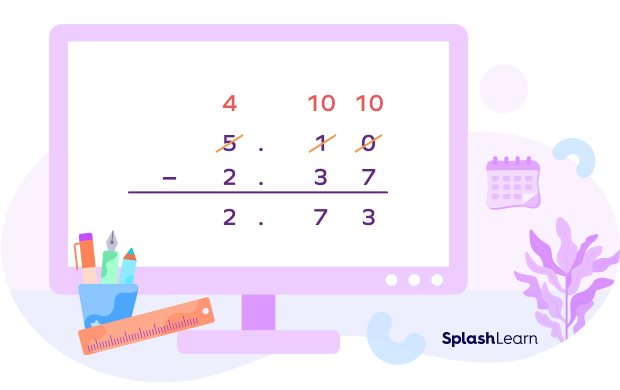
Subtracting Decimals from Whole Numbers
Let’s say we are subtracting decimal 0.569 ( a decimal number) from 3 (a whole number). Here’s how to do it:
Step 1: The first step is to convert the whole number into a decimal number. To do that, we add a decimal point and the required number of zeroes to the right of the whole number.
Remember, the number of the zero added should match the length of the other decimal number given.
Here, we will add three zeros after 3 to match 0.569. So 3 will become 3.000.
Step 2: Position the smaller number below the greater number in such a way that the decimal points are lined up.
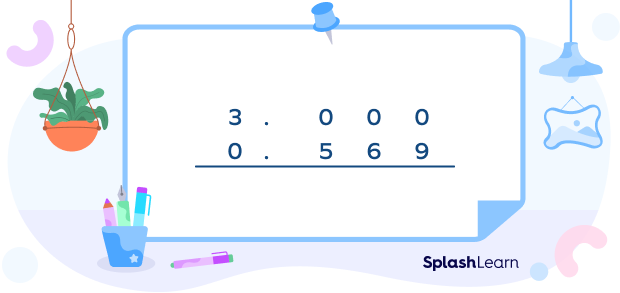
Step 3: Subtract the numbers by following the usual method of subtracting decimal numbers.
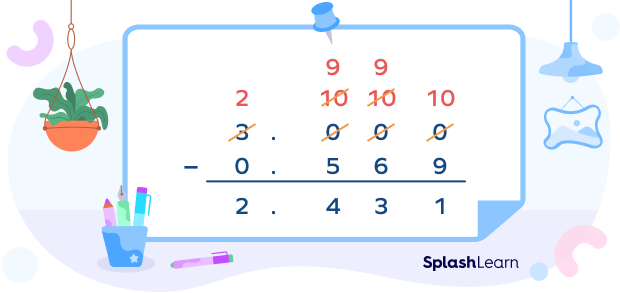
Use of Subtraction of Decimal in Real Life
Subtraction of decimals is used in various day-to-day activities, some of which are as follows:
- Monetary transactions: A dozen eggs cost $\$$5.50, but we pay $\$$10 to the store clerk. Then, to return the balance amount, the store clerk gives us $\$$4.50 back.
- Fuel purchase: You pay $\$$13.8 to get 10 litres of gas for your car.

- Scientific calculations: Scientists use decimal numbers to get accurate readings in their experiments.
- Medical readings: When using a thermometer to measure the body temperature, it will show you the readings in decimal numbers, like 98.6° F.
- Construction measurements: Construction projects require measurements of the length, breadth, and height of various things, which are represented through decimal numbers.

- Health and fitness: Various fitness equipment used in gyms like dumbbells, weight lifts, etc., have a definite weight limit, like 8 lbs or 10 lbs so that you can proceed with your fitness training as per your capabilities. The treadmill will show you the miles you have walked or run through decimal numbers. Weighing machines also display the weight in decimals.

- Odometers: You can calculate the distance traveled in your car or bike by the odometer, which uses decimal points to show the precise reading.

Solved Examples
Example 1: Subtract 0.30 from 0.70.
Solution:

Example 2: Subtract 0.25 from 5.22.
Solution:
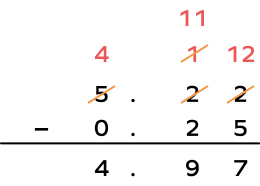
Example 3: Subtract 86.9 from 635.78.
Solution:
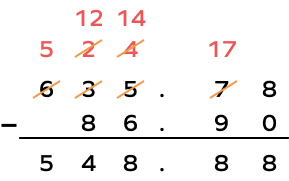
Practice Problems
Subtracting Decimals - Definition With Examples
Subtract 8.20 from 9.57 and select the right option.
$9.57 − 8.20 = 1.37$

Subtracting decimal number 1.33 from which number will give you 6.67 as the answer?
To find the answer, you can add the other decimal number with the result.
Hence, the missing decimal number is 8.

Subtracting decimal number 79.98 from 298.20, gives the answer 216.30. Is the statement true or false? Explain.
On subtracting decimal number 79.98 from 298.20, we get 218.22 and not 216.30
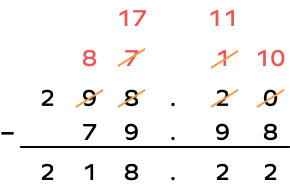
Subtract 11.239 from 36.1.
First, we need to change decimal numbers to like-decimal numbers by adding zeros. So, 36.1 will be re-written as 36.100
Then:
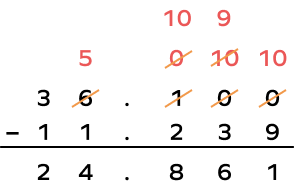
Frequently Asked Questions
Can subtracting decimal numbers result in a whole number?
Yes, by subtracting decimal numbers, you can get a whole number as the result. However, the digits after the decimal point must be the same for both the decimal numbers.
For example, if you subtract 1.25 from 4.25, the answer will be 3, which is a whole number.
How can I check if I have subtracted two decimal numbers correctly?
To check if your answer after subtracting decimal numbers is correct, you can add the result with the smaller decimal number. If the answer is right, you will get the greater decimal number as the result.
For example, if you subtract 2.33 from 9.01, the answer you get is 6.68. Now, if you want to check your answer, add 6.68 to 2.33. The result you get is 9.01, which means the answer is correct.
Can I subtract a whole number from a decimal number?
Yes, the whole number can be rewritten as a decimal number by adding zeros after the decimal point. Then the process is the same as subtracting decimal numbers.
| Fun Facts – The Chinese were the first people to use and develop fractions or decimal numbers. |




































